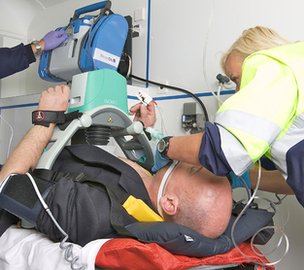University Hospital Zurich
Raemistrasse 100 Zurich, Zurich (Switzerland)
German Hospital Service
Destouchesstr. 1 Munchen, Bayern (Germany)
Moorfields Eye Hospital NHS Trust
162 City Road London, Greater London (UK)
Flinders Medical Centre
Flinders Drive, Bedford Park South Australia (Australia)
UK trial for portable braincooling device

A trial has begun of a portable braincooling device which could enhance the survival prospects of cardiac patients
Groundbased cars in the service of the charity Londons Air Ambulance are the first in the UK to carry the Rhinochill machine
Larger braincooling devices are already used in UK hospitals on cardiac and stroke patients to aid recovery
But cooling the body earlier in the field during resuscitation could save more lives early research suggests
We know quite well that if youre cooled after your heart attack it can not only mean that your chances of surviving are greatly increased but your chances of surviving without brain damage are too Dr Richard Lyon a registrar with Londons Air Ambulance told BBC News
For the last 10 years or so the big thrust has been to cool you as quickly as possible but usually after you get delivered to hospital after your heart has been restarted
What were doing is bringing everything much further forward starting this braincooling process while CPR is still being carried out in the field
So far the team have used the machine five times with funding for 20 patients over the next year The money for the trial has been awarded by the College of Emergency Medicine
The device made by Californiabased company Benechill works by delivering a cold current of air up the nostrils via tubes cooling the brain and body
Cardiologist Dr Duncan Dymond explains what goes wrong when we have a heart attack
Animal research suggests cooling the brain earlier could have a major impact on survival and recovery prospects for patients
The machine is being carried by the Physician Response Unit a vehicle dubbed the cool car which operates during daytime hours and responds to trauma and cardiac emergencies across the capital
Essentially its a very small unit which contains a fluorocarbon liquid You plug the thing into an oxygen cylinder which then vaporises this liquid and the vapour comes out of the end of two nasal cannulai explained Dr Lyon
We put two tubes into the back of the nose about half an inch from the brain and this cold spray which comes out at about four degrees cools the inside of your nasal cavity very rapidly and that cools the brain
The braincooling unit will be used by the paramedics and doctors in conjunction with defibrillation and cardiopulmonary resuscitation CPR
Someones got to be doing CPR and we often use a mechanical device to do that someones got to be putting a tube into the lungs and someones got to work the defibrillator and then theres the cooling nasal spay he said
Commenting on the study Dr Gareth Davies medical director and chairman of the trustees of Londons Air Ambulance said Londons Air Ambulance prides itself on delivering medical innovation to increase the survival and recovery of its patients
Date : 03 May, 2012
Reference : http://www.bbc.co.uk/news/health-17869134
